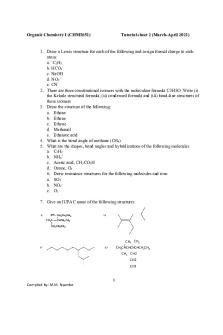Tutorial 2 - Inorganic Mechanisms 2 PDF

| Title | Tutorial 2 - Inorganic Mechanisms 2 |
|---|---|
| Author | Hamza Subhani |
| Course | Inorganic Chemistry 3 |
| Institution | University of Huddersfield |
| Pages | 2 |
| File Size | 77 KB |
| File Type | |
| Total Downloads | 89 |
| Total Views | 171 |
Summary
Paul Elliott 16/17...
Description
SHC4001 Inorganic Chemistry 3 – Tutorial 2
Inorganic Mechanisms 2 - Electron Transfer Reactions 1.
How can inner sphere electron transfer reactions be distinguished from outer sphere electron transfer reactions?
2.
Suggest giving reasons which electron transfer mechanism is operating in the following reactions
i) [Cr*(H2O)6]3+ + [Cr(H2O)6]2+ → [Cr*(H2O)6]2+ + [Cr(H2O)6]3+ k = 10-5 M-1 s-1 ii) [Cr*(H2O)5F]3+ + [Cr(H2O)6]2+ → [Cr*(H2O)6]2+ + [Cr(H2O)5F]3+ k = 0.02 M-1 s-1 iii) [Cr*(H2O)5Cl]3+ + [Cr(H2O)6]2+ → [Cr*(H2O)6]2+ + [Cr(H2O)5Cl]3+ k = 9.0 M-1 s-1 Explain why the rate constant for the reduction of [Co(NH3)5(OH)]2+ by
3.
[Cr(H2O)6]2+ is 107 times faster than that for [Co(NH3)5(H2O)]3+ and why the rate of reaction of [Co(NH3)5(H2O)]3+ is proportional to 1/[H +]. 4.
Explain the differences between the rate constants for the following outer sphere self-exchange electron transfer reactions
5.
i)
[Ru(H2O)6]2+ / [Ru(H2O)6]3+ k = 4 x 103 M-1 s-1
ii)
[Cr(H2O)6]2+ / [Cr(H2O)6]3+ k = 10-5 M-1 s-1
iii)
[Co(NH3)6]2+ / [Co(NH3)6]3+ k = 10-6 M-1 s-1
Give the oxidation states, d-electron counts and spin state (HS or LS) of the three following complexes and hence deduce which one is able to undergo an inner sphere reaction with [(NH3)5Co(NCS)]2+. [Cr(H2O)6]2+
[Fe(CN)6]4-
[Co(CN)5]3-
SHC4001 Inorganic Chemistry 3 – Tutorial 2
6.
The ambidentate ligand NCS- usually binds to hard metal ions through the N-atom. Suggest how the S-bound complex [(NH3)5Cr(SCN)]2+ could be prepared. Write out a reaction mechanism to explain your answer.
7.
Using the following electrochemical and self-exchange rate data calculate the rate of the oxidation at 298 K of [Cr(OH2)6]2+ (E = -0.41 V, kself = 1 x 10-5 dm3 mol-1 s-1) by a) [Fe(OH6)]3+ (E = +0.77 V, kself = 1.1 dm3 mol-1 s-1) and b) [Ru(bpy)3]3+ (E = +1.26 V, kself = 4 x 108 dm3 mol-1 s-1). Assume f12 = 1....
Similar Free PDFs

Tutorial 2 - tut 2
- 5 Pages

Tutorial 2 - Wk 2
- 6 Pages

Tutorial-2
- 1 Pages

Tutorial 2
- 3 Pages

Tutorial #2
- 2 Pages

Tutorial 2
- 1 Pages

Tutorial 2 - .....
- 3 Pages

Tutorial 2
- 3 Pages

Tutorial 2
- 2 Pages

Lab 2 treeage tutorial 2
- 10 Pages

ECON2004 Term 2 Tutorial 2
- 5 Pages

2 - nursing tutorial week 2
- 3 Pages
Popular Institutions
- Tinajero National High School - Annex
- Politeknik Caltex Riau
- Yokohama City University
- SGT University
- University of Al-Qadisiyah
- Divine Word College of Vigan
- Techniek College Rotterdam
- Universidade de Santiago
- Universiti Teknologi MARA Cawangan Johor Kampus Pasir Gudang
- Poltekkes Kemenkes Yogyakarta
- Baguio City National High School
- Colegio san marcos
- preparatoria uno
- Centro de Bachillerato Tecnológico Industrial y de Servicios No. 107
- Dalian Maritime University
- Quang Trung Secondary School
- Colegio Tecnológico en Informática
- Corporación Regional de Educación Superior
- Grupo CEDVA
- Dar Al Uloom University
- Centro de Estudios Preuniversitarios de la Universidad Nacional de Ingeniería
- 上智大学
- Aakash International School, Nuna Majara
- San Felipe Neri Catholic School
- Kang Chiao International School - New Taipei City
- Misamis Occidental National High School
- Institución Educativa Escuela Normal Juan Ladrilleros
- Kolehiyo ng Pantukan
- Batanes State College
- Instituto Continental
- Sekolah Menengah Kejuruan Kesehatan Kaltara (Tarakan)
- Colegio de La Inmaculada Concepcion - Cebu



